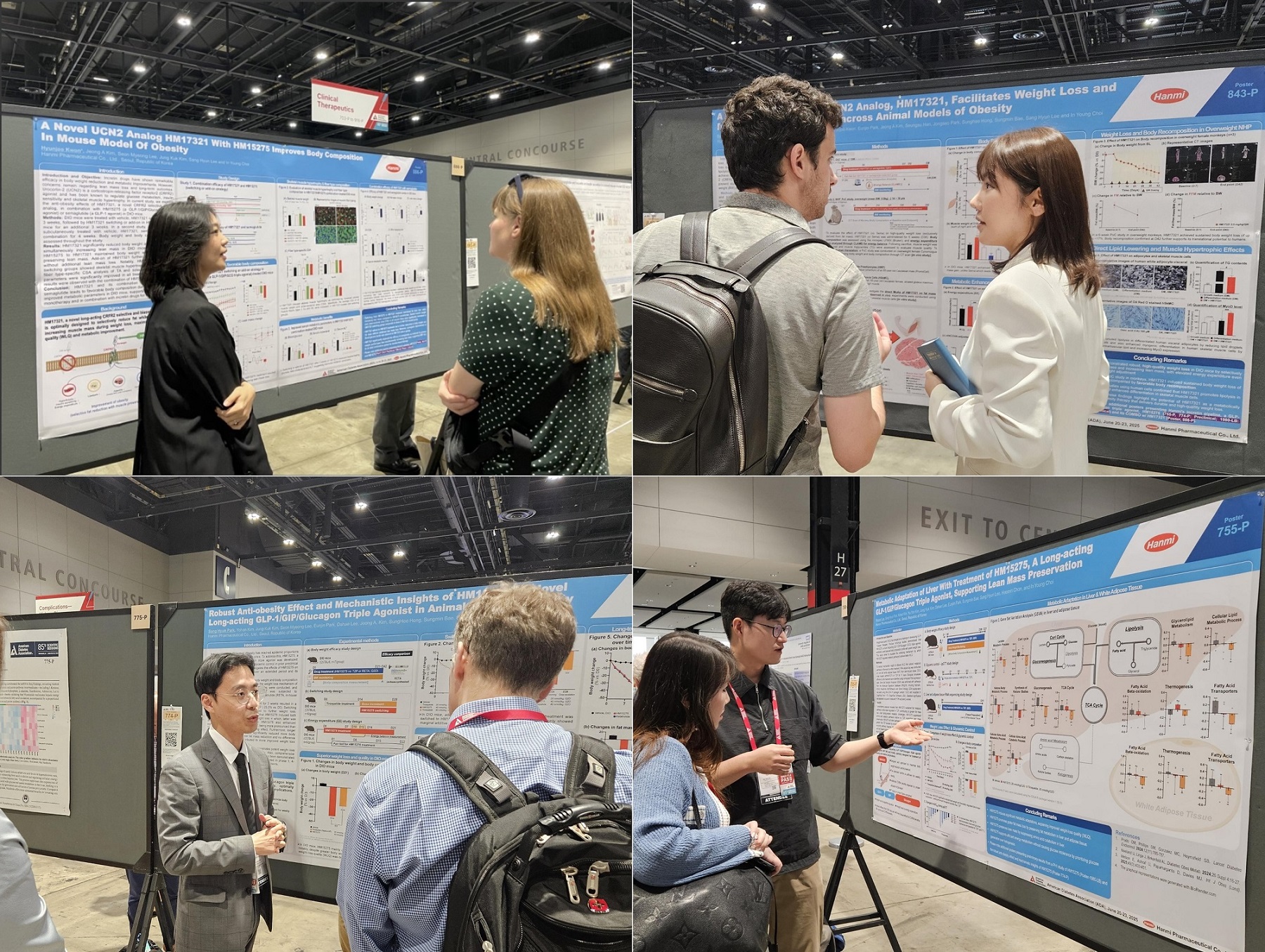Hanmi’s Next-Gen Obesity Drug Gains Momentum: Nearly 5% Weight Loss After 4 Weeks, Up to 10% in Individual Case
Hanmi’s Next-Gen Obesity Drug Gains Momentum: Nearly 5% Weight Loss After 4 Weeks, Up to 10% in Individual Case
Hanmi Showcases Six Research Updates on Obesity Drug Candidates at ADA 2025
Triple-Agonist HM15275 Phase 1 Data Reveal Favorable Safety and 5% Mean Weight Loss After Four Weeks
HM17321 Shows Both Quantitative and Qualitative Improvements in Weight Loss

Researchers from Hanmi R&D Center presented key findings on next-generation obesity drugs HM15275 and HM17321 to attendees at the American Diabetes Association (ADA) 2025 conference on June 22.
(June 27, 2025) Hanmi Pharmaceutical is accelerating its journey toward becoming a forerunner developer of next-generation obesity drugs.
The company announced that it presented six posters featuring clinical and preclinical data on its novel long-acting GLP-1, GIP and glucagon receptor agonist (HM15275) and CRFR2 selective urocortin 2 analog (HM17321) at the 85th Scientific Sessions of the American Diabetes Association (ADA) held in Chicago from June 20 to 23.
Among the highlights were early-stage findings demonstrating more rapid and potent weight loss of HM15275 compared to currently available obesity drugs, as well as compelling results of HM17321 in animal models showing concurrent fat loss and muscle gain. These results underscore Hanmi’s potential to reshape the global obesity treatment landscape through triple-mechanism and first-in-class innovations.
◆ Phase 1 MAD Study Confirmed HM15275’s Safety and Tolerability, Achieving Up to 10 % Weight Loss after Just Four Weeks
Hanmi unveiled Phase 1 trial results for HM15275, capturing the attention of the international biopharma community. Importantly, while the previously released abstract included only lower-dose data, the presentation revealed outcomes from the highest dose group (8 mg), further reinforcing HM15275’s therapeutic promise.
The Phase 1 trial enrolled 74 healthy and obese adults to evaluate the safety, tolerability, pharmacokinetics (PK), and pharmacodynamics of HM15275 after single and multiple subcutaneous doses administered once weekly over a four-week period. Results showed a favorable safety and tolerability profile, with PK properties consistent with long-acting activity. In the highest multiple ascending dose cohort (0.5-2-4-8 mg), participants achieved a mean placebo-adjusted body weight reduction of 4.81% by Day 29. The subject showing the greatest response recorded a weight loss of 10.64% by Day 43.
"We successfully achieved the primary objective of confirming safety in the Phase 1 trial and secured data to determine the starting dose and escalation scheme for Phase 2," said Moon Hee Lee, Head of General Medicine Clinical Team at Hanmi Pharmaceutical. "Based on the favorable safety profile observed, we plan to initiate a longer-term Phase 2 study within the year, including much higher doses beyond 8 mg."
She added, "Given the promising 4-week data, we are confident that extended dosing could yield outcomes surpassing those of leading obesity treatments currently on the market."
The non-clinical evaluations of HM15275 presented at ADA 2025 highlighted HM15275’s differentiated efficacy compared to currently marketed agents.
In animal models of obesity, repeated administration of HM15275 resulted in greater weight loss than semaglutide (Wegovy®) or tirzepatide (Zepbound®). Notably, when transitioned from tirzepatide to HM15275, additional weight reduction was observed, suggesting that the compound’s triple agonist mechanism, which simultaneously suppresses appetite and promotes energy metabolism, may exert a synergistic effect.
HM15275 also demonstrated superior long-term efficacy over retatrutide, another triple agonist, with greater fat mass reduction while preserving muscle mass―a key differentiator in its therapeutic profile.
Transcriptomic analyses from obese animal models revealed that HM15275 promotes lipolysis, suppresses amino acid catabolism, and activates glucose-based energy metabolism. These findings support the dual benefits of "weight loss quality" and "metabolic balance."
◆ HM17321 Facilitates Weight Loss and Improves Body Composition across Animal Models of Obesity
Hanmi also presented three preclinical studies on HM17321 designed to deliver what has long been considered physiologically unattainable: “Burn Fat, Build Muscle.”
HM17321 is a urocortin 2 (UCN2) analog that selectively targets the corticotropin-releasing factor receptor 2 (CRFR2). It is being developed as a first-in-class obesity treatment with dual action, inducing fat loss and muscle mass increase, thereby maximizing weight loss quality and metabolic improvement.
Hanmi presented new findings demonstrating that HM17321 delivered not only significant weight loss but also meaningful improvements in body composition in animal models, including monkeys.
In obese mice and rats, HM17321 induced marked body recomposition effects, including increases in muscle mass that led to elevated basal metabolic rate, indicating that the newly formed muscle was metabolically active and functionally beneficial.
Similarly, HM17321 showed consistent results in monkeys, demonstrating robust weight loss alongside improvements in body composition, thereby confirming the compound’s reproducible efficacy across preclinical species.
Mechanistic studies further demonstrated that HM17321 promotes lipolysis in human-derived adipocytes and contributes to muscle development by enhancing skeletal muscle cell differentiation. These findings indicate that HM17321 drives both quantitative and qualitative improvements in weight loss.
Hanmi stated that these outcomes represent a significant milestone, validating the human translational potential of this novel UCN2-based mechanism at the preclinical stage.
Another study showed that in addition to its muscle-enhancing effects, HM17321 may also improve insulin resistance and glycemic control through direct action on muscle tissue, indicating potential indication expansion into the treatment of type 2 diabetes.
Hanmi also presented data supporting a combination therapy strategy for HM17321 with incretin-based agents.
Unlike antibody-based muscle-preserving treatments, which often require complex and less patient-friendly administration, HM17321 is a peptide-based compound, offering ease of administration and cost-effectiveness. If developed as a combination therapy, HM17321 can be co-formulated with GLP-1 agonists in a single injection, significantly enhancing patient convenience and adherence.
“Hanmi’s research capabilities and development expertise in obesity and metabolic diseases are not only the best in Korea, but are increasingly recognized on the global stage,” said Dr. In Young Choi, Head of R&D at Hanmi Pharmaceutical. “As the global pharmaceutical landscape continues to shift toward obesity therapeutics, we will continue to strengthen our position as a true front-runner in this field.”
■ Contact info:
Official Websites: www.hanmipharm.com
innovation@hanmi.co.kr, +82-2-410-0467